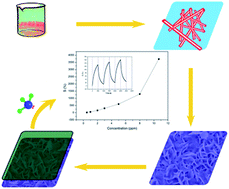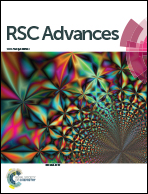Facile preparation of a composite of TiO2 nanosheets and polyaniline and its gas sensing properties†
Abstract
Gas sensors based on a composite of TiO2 nanosheets and polyaniline (PANI) were fabricated by the deposition of water-dispersible PANI on interdigitated gold electrodes decorated with TiO2 nanosheets via dip coating. Specifically, the TiO2 nanosheets were in situ grown on the electrodes by a simple hydrothermal treatment of the electrospun nanofibers of poly(methyl methacrylate) containing a tetrabutyl titanium precursor at a temperature as low as 135 °C in the presence of only water. The method circumvents high temperature calcination and is environmentally friendly. The structure and morphology of the TiO2 nanosheets and their nanocomposites with PANI were characterized by Fourier-transform infrared spectroscopy, X-ray diffraction spectroscopy, scanning electron microscopy, and high resolution transmission electron microscopy. The nanocomposite exhibited highly sensitive (detection limit as low as ∼45 ppb), selective and repeatable electrical responses towards NH3 at room temperature, which is better than those of the separate components and demonstrates an obvious synergetic effect. The enhanced sensing properties of the nanocomposite are proposed to relate to the high specific surface area and the p/n heterojunction between TiO2 nanosheets and PANI.


 Please wait while we load your content...
Please wait while we load your content...